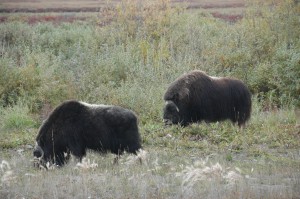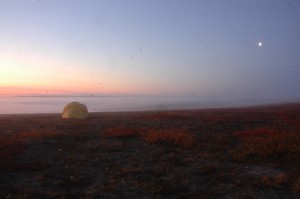How much does the ‘Drill America First crowd’ really know about oil in Alaska?
Coldfoot, Alaska — Traffic backed up behind us on the Dalton Highway as we stopped to let the musk ox have his way with the road. He confronted our red Ford pickup, affectionately known as the “Big Red Taxi,” with the demeanor of an armed man protecting his family and the stance of a bull ready to rock Pamplona.
We were on the Haul Road looking for oil. He was on the Haul Road protecting his harem, munching on ditch grass, from the likes of us. He was armed with his head and horns, which could easily take out our Big Red Taxi if he decided to charge. So we waited. He won as we waited him to saunter off the asphalt and into the ditch, all the while glaring at us out of the corner of his musk ox eye.

Despite hand-wringing from the Drill America First crowd that somehow the White House and Congress are keeping billions of barrels of oil under wraps because of inconsequentials like caribou, musk ox and millions of migratory birds, there is plenty of new oil exploration and drilling pressure going on outside of ANWR. The efforts are moving so fast that there is a shortage of drilling rigs in the North Slope.
We were prospecting for oil in the age-old tradition of finding it exposed in sediment. I was the shepard for Pete Flaig, a University of Texas-based geologist. It’s one of the many jobs I have done in my life as an avid outdoorsman. This one a little more recent.
Alaska’s geologic history easily unfolds to the eye along river bluffs that have been eroded by rivers, exposing more than 200 million years of planet activity. Black coal lines along the bluffs mean that there’s oil in them thar hills [although the North Slope is pretty much flat, except along the rivers].
The cliffs of the Sagavanirktok River were the location of our mini-mountaineering exploration. The river happens to run along the Haul Road, which is the artery through the North Slope to Prudhoe Bay out of Fairbanks.
There is oil everywhere up here. But it’s difficult to get to, given the geology of the region. Pete’s job was to work the bluffs to note where oil possibly sits below the surface to project where it may lay further inland where the drilling rigs can be fired up. It has to do with the sand and the coal lines and how they run along the bluff. A drop in the level of where the coal and sand is found along the bluffs can be projected inland to direct where the drilling should occur. Pete’s job was to take bluff samples, lots of notes, and even more pictures of rock formations. Analyzing would take place in an air-conditioned, bug-free environment.” My job was to spot Pete and make sure to rescue him if he fell off the bluff. I also carried the day’s tools and supplies.
“Here smell this,” Pete said, handing me a grayish-black hunk of rock. The powerful odor of kerosene filled my nostrils. Pay dirt.

Oil prospecting companies can bring out the exploratory drilling rigs only for test wells in the winter months, because the heavy rigs will wreck the fragile tundra. In contrast to the semi-trailer type housing crews work out of in winter, we camped in much more eco-friendly tents at gravel pits that line the Haul Road, which were created to build the two-lane thruway for supplies to get from Fairbanks to Prudhoe Bay and build the pipeline. We also had to walk several hours across the ankle- and knee-busting tundra to get to the bluffs.
Nonetheless, pressure from oil companies is mounting to make it easier for them to find the vast resources of crude up here. They want to drive to where they can dig their wells and not have to wait for winter. An irony here is that global warming is reducing the number of winter days that rigs can move across the tundra.
The Haul Road is the only road through the North Slope. Its 415 miles is the location of continuous semis laden with supplies for Prudhoe Bay workers and their rigs. To the west of the road is the vast expanse that includes the National Petroleum Reserve and some 22 billion barrels of oil and 120 trillion cubic feet of natural gas.
To the east is the contentious Arctic National Wildlife Refuge, 19 million acres where drilling is banned.

Oil companies want the state to build a road heading 100 miles to the west to get to the borders of the National Petroleum Reserve to ramp up their drilling. It’s been the works since 2003. The road would end at Umiat, an airstrip enclave along the Colville River that was built by the Navy during World War for the sole purpose of drilling for oil. Many started wells are in the area and new technology makes it easier for extraction these days.
The road has been mapped, but questions over the impact on caribou and other animal migration have to be answered sufficiently before the bulldozers arrive. The road would also come with a pipeline carrying oil and natural gas to the main Trans-Alaska Pipeline, which runs along the Haul Road. That pipeline was built partly on stilts to let caribou pass underneath, so they got that going for them.
While the road’s environmental hurdles are slowing its progress, the Obama Administration has given the go-ahead for offshore drilling in the Arctic Ocean, which began in earnest by Shell Oil just last month. Shell spent seven years and $4 billion overcoming environmentalist and native Inupiat opposition to get that going. The concerns have not been allayed, however, but ballooning gas prices ruled the day for the administration.
Fouled Up Fracking Research: Speaking of oil, most of the fracking world admits that latest trend in oil and gas mining threatens water quality wherever it’s done. Hydraulic fracking is the drilling tactic that pumps chemical-laden liquid into faults in the ground to release oil and natural gas to the surface. The industry tends to keep mum on exactly what chemicals it uses in drilling and it varies from operation to operation.
States and the feds are quickly trying to pass legislation requiring more stringent reporting on what chemicals are being used. Frackers, of course, say the rules are to stringent.
But Texas professor Charles “Chip” Groat issued a study earlier this year saying that there is no worry over groundwater pollution. Groat was sounding like a voice in the wilderness outside the fracking industry, bucking conventional wisdom on the topic.
Texas is drooling over the prospect of an estimated $229 billion in oil projects that are expected to put some 125,000 people to work over the next 25 years.
Last week, however, Groat’s credibility was flushed as it was found out he actually is an “oil industry insider.” Groat happens to be a paid director of a major oil and gas exploration company in Texas and also happens to own 40,000 shares of the company Plains Exploration and Production. The people who worked with him on the study say they knew nothing.
Try again guys.

Doug Hissom writes a weekly environmental column for Baltimore Post-Examiner. He has covered local and state politics in Wisconsin for more than 20 years. Over the course of that time he was publisher, editor, news editor, managing editor and senior writer at the Shepherd Express weekly paper in Milwaukee. He also covered education and environmental issues extensively. He ran the UWM Post in the mid-1980s, winning a Society of Professional Journalists award as best non-daily college newspaper. An avid outdoors person he regularly takes extended paddling trips in the wilderness, preferring the hinterlands of northern Canada and Alaska. After a bet with a bunch of sailors, he paddled across Lake Michigan in a canoe.

